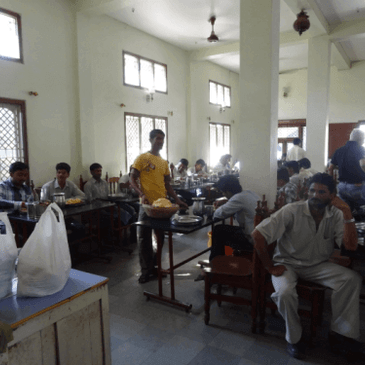CNC: Cost per cutting edge – why it is lower for a negative insert
A negative insert, like the VNMG insert in the picture, has a zero relief angle. Both faces of the insert are therefore the same, and you get cutting edges on both.

Positive inserts, like the VBMT insert in the picture, have a non-zero relief angle. Only one face of the insert has cutting edges. The bottom face is unusable for cutting, and is only used for resting on the tool holder’s pocket. The example here is for the V (35 degree) insert, but this logic applies to any shape – D, R, S, T, etc.
The cost of a positive and negative insert is almost the same, but if you get twice the number of cutting edges you are halving the cost per cutting edge. So use a negative insert whenever possible. Read this post for a detailed explanation on the difference between positive and negative inserts, and their applications (the ‘whenever possible’).
Simple rule
The second alphabet of an insert’s name (e.g., B in VBMT) is the relief angle. N means 0 degrees, a negative insert. Any other alphabet means a non-zero angle, a positive insert (E.g., B is 5 degrees, C is 7, P is 11).
If the second alphabet in the insert name is N, you’ll typically get twice the number of cutting edges. If it is any alphabet other than N, you get cutting edges only on one face. E.g., VBMT160408 has 2 edges, VNMG160408 has 4 edges.
Text and pics. source: CADEM NCyclopedia multimedia CNC training software.

Etc.
Lunch in Gurudatta Bhojanalaya, Gulbarga
When I travel to North Karnataka, one of the pleasures that I look forward to is eating a vegetarian meal in a Khanavali. A Khanavali is the local name for a simple no-nonsense restaurant that serves only local food. Clean, no great ambience, no booze – you only go there to eat.


The plate in the picture has jowar roti, onions, onion stem palya (sabzi), bitter gourd palya, rajma + palak palya, groundnut chutney and buttermilk.
This mix of salad (which could be methi leaves, radish leaves, onion leaves, or radish or onion), legumes, cooked vegetables and roti is a standard at every meal. Beautifully balanced, something that a dietitian would approve of – mix of proteins, carbs, veggies, fibre, etc.
Jowar (Sorghum in English) is a millet that is a close cousin of Ragi, Bajra, Quinoa and a bunch of other millets. All these have a close family resemblance – they’re about 1 mm. in diameter, hard and fibrous. North Karnakata’s staple food is jowar and bajra rotis, against the south’s rice and ragi.


There is no such thing as a free lunch, of course. The food in Gulbarga is spicy. If you’re someone whose spice tolerance is low, pigging out on such food has its effects the next day, when various unmentionable parts of your anatomy keep reminding you that they exist. I am a low spice guy, but in matters of food I follow the famous quote, “You are only here now; you’re only alive in this moment”. Tomorrow is another day, no ?


